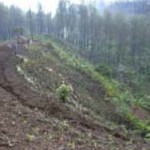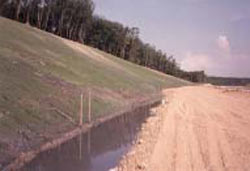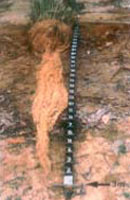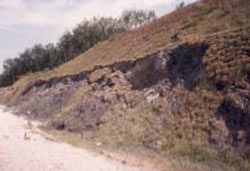Bioengineering (Indonesia)
The planting of vegetation on slopes as a perceived method of stabilisation is a commonpractice. In particular grass species such as Vetiver grass are considered appropriate as the rooting depth can be up to 3 metres and the grass has a water shedding properties.
These two apparent characteristics of reinforcement and reduction in ‘effective rainfall’ render such type species particularly popular in the context of new construction in sub-Tropical and tropical countries where precipitation levels are high.

Land-use change on slopes is another important aspect of bioengineering. For example inIndonesia de-forestation has led to slope instability: Evidence of slope instability following de-forestation, West Java, Indonesia
CHASM facilitates the inclusion of specified [or user-defined] vegetation type on each column of the finite difference grid, for which the rooting depth can be individually assigned. The root area ratio is used as a driver for changes to soil hydraulic conductivity and the provision of tensile strength. Thus the effect of bioengineering practice on slope stability can be assessed. This is particularly important if immediate post-construction failures are to be minimised:

Reference:
Wilkinson P. L., Anderson M. G, Lloyd, D.M & J-P. Renaud , 2002, Landslide hazard and bioengineering: towards providing improved decision support through integrated model development. Environmental Modelling and Software, 17, 333-34


